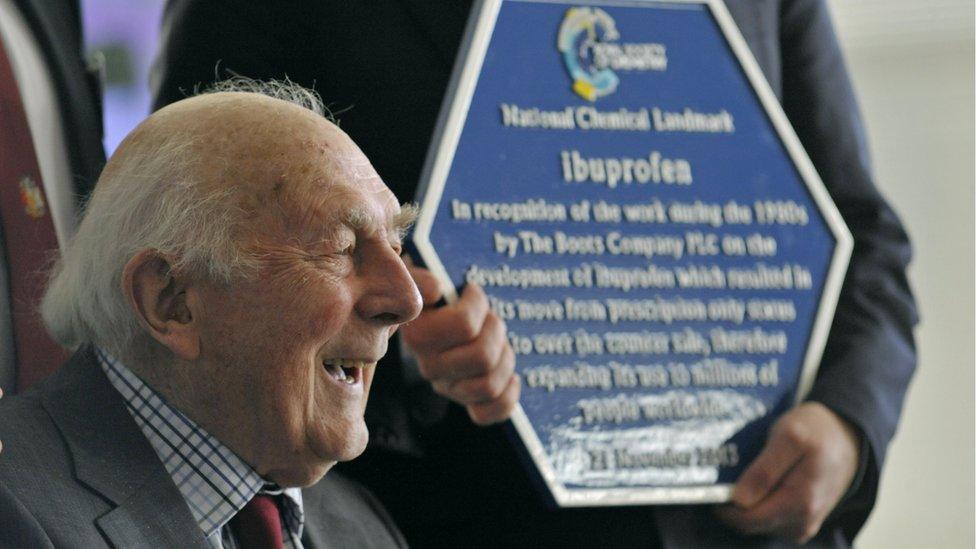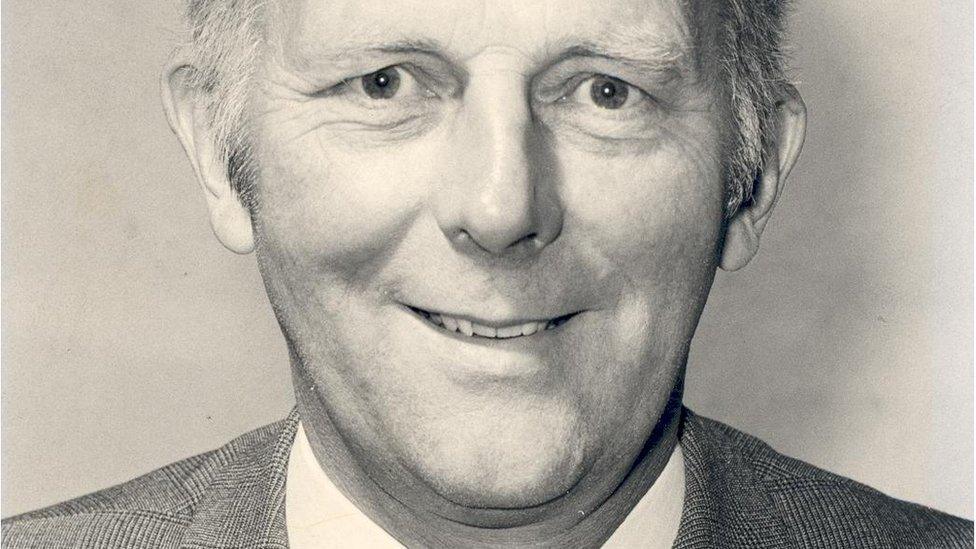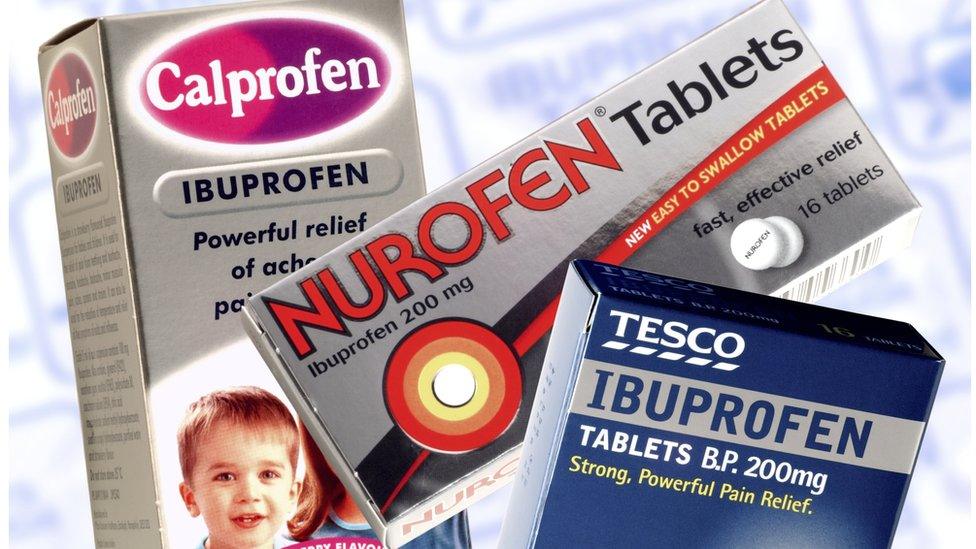The hangover that led to the discovery of ibuprofen
- Published

Dr Stewart Adams has been honoured for his research which led to the discovery of ibuprofen in the 1960s
Dr Stewart Adams knew he had found a potential new painkiller when it cured his hangover ahead of an important speech.
"I was first up to speak and I had a bit of a headache after a night out with friends. So I took a 600mg dose, just to be sure, and I found it was very effective."
Now 92, Dr Adams remembers the years of research, the endless testing of compounds and the many disappointments before he and his research team pinpointed ibuprofen as a drug with potential more than 50 years ago.
It has since become one of the world's most popular painkillers. No medicine cupboard in the modern home is complete without some ibuprofen.
Got a fever? Headache? Back pain? Toothache? Then ibuprofen, external is most likely to be the drug of choice because it's fast-acting and available over the counter.
Its popularity for treating aches and pains is not just a UK phenomenon however. In India, for example, it is the preferred treatment for fever and pain and in the US, it has been an over-the-counter drug since 1984. It is also used to treat inflammation in conditions like arthritis.
And as Dr Adams himself discovered on a trip to Afghanistan in the 1970s, even remote village pharmacies along the Khyber Pass were selling his wonder drug.
But, he says modestly, the discovery didn't change his life at all.
Search for a challenge
It all started with a 16-year-old boy from Northamptonshire, who'd left school with no clear plan for his future.
He started an apprenticeship in retail pharmacy at Boots and the experience whetted Stewart Adams' appetite for a more challenging career.
This led to a degree in pharmacy at Nottingham University followed by a PhD in pharmacology at Leeds University, before he returned to the research department at Boots Pure Drug Company Ltd in 1952.
His mission at that time was to find a new treatment for rheumatoid arthritis which was as effective as a steroid but without any of the side-effects.

Dr Stewart Adams spent his whole career at Boots UK, researching and developing non-steroidal anti-inflammatory drugs
He started looking at anti-inflammatories and, in particular, the way aspirin worked, which no-one else appeared to be doing.
Aspirin was the first non-steroidal anti-inflammatory drug to be developed, in 1897.
Although aspirin was commonly used as a painkiller at the time, it had to be given in very high doses so the risk of side-effects, such as an allergic reaction, bleeding and indigestion, was high. This meant that by the 1950s it was falling out of favour in the UK.
Ten years of research
In the search for an alternative, Dr Adams recruited chemist Dr John Nicholson and technician Colin Burrows to help him test the potency of more than 600 chemical compounds. The key was to find a drug that would be well tolerated.
From the front room of an old Victorian house in the suburbs of Nottingham, the small team patiently tested and re-tested compounds until they found something worth trying on patients in the clinic.
Dr Adams realised his chances of success were minimal but he and his staff persevered over 10 long years.
"I did think we would succeed eventually - I always felt we would succeed."
And he was always prepared to act as guinea pig, testing two or three compounds on himself.

Ibuprofen is now made by a range of different companies under many different brand names
That would never be allowed now, he admits, but they were careful to carry out toxicity tests beforehand.
"It was important to try them out and I was excited to be the first person to take a dose of ibuprofen," he remembers.
During that time, four drugs went to clinical trials and failed before, in 1961, they settled on one called 2-(4-isobutylphenyl) propionic acid, later to become ibuprofen.
A patent for ibuprofen was granted to Boots in 1962 and it was approved as a prescription drug seven years later.
According to Dave McMillan, former head of healthcare development at Boots UK, ibuprofen was an extremely important drug to the company.
"It saved Boots, helped it to expand into the US and all round the world. It was Boots' number one drug."
An incredible 20,000 tonnes of ibuprofen are now made every year by a range of different companies under many different brand names. There are different forms of it too, including liquid forms specifically designed for children.
Dr Adams has been honoured for his research, with an honorary doctorate of science from the University of Nottingham, and two blue plaques from the Royal Society of Chemistry. He remained with Boots UK for the rest of his career, becoming head of pharmaceutical sciences.
What he is most pleased about is that hundreds of millions of people worldwide are now taking the drug he discovered.
It was a long road - but a very important one. And it all began with a sore head.

How does ibuprofen work?
It is a non-steroidal anti-inflammatory drug or (NSAID). Because it has a different chemical structure to steroids, it is not as toxic.
It reduces pain by targeting compounds called prostaglandins which cause inflammation in the body.
Inflammation can bring on swelling, heat, redness, loss of function, fever and pain.
The painkilling effect begins soon after a dose is taken, but it can take longer for the inflammation to reduce.
Ibuprofen's success has been in treating minor aches and pains.
NHS Choices says it should be taken at the lowest possible dose for the shortest possible time because it can cause side-effects such as nausea and vomiting, external.

TIMELINE FOR IBUPROFEN DISCOVERY
1950s - Work starts to find a drug to treat rheumatoid arthritis that has no side-effects
1958 - After hundreds of compounds are made and screened for activity, a compound called BTS 8402 is given a clinical trial but it is found to be no better than aspirin
1961 - A patent is filed for the compound 2-(4-isobutylphenyl) propionic acid - later called ibuprofen
1966 - Clinical trials of ibuprofen take place in Edinburgh and its anti-inflammatory effect is seen in patients
1969 - Ibuprofen is launched in the UK on prescription only
1983 - Ibuprofen becomes available over the counter because of its safety record